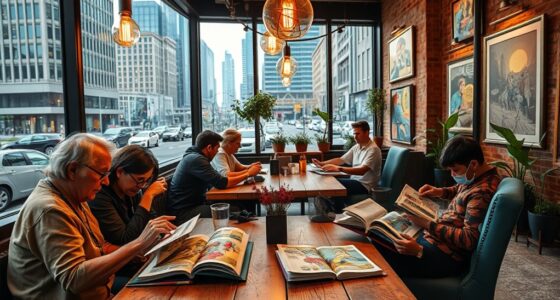Step into Beat Generation cafés where coffee fuels spontaneous poetry, jazz sets the mood, and rebellious spirit runs deep. These lively spaces evoke 1950s counterculture, inviting you to challenge norms and embrace authenticity. Walls tell stories of iconic writers, while open mic nights spark raw, unfiltered expression. The atmosphere celebrates questioning conventions and stirring souls, making these venues more than just cafés—they’re hubs of protest and self-discovery. Keep exploring to uncover more about this vibrant world.
Key Takeaways
- Beat cafés evoke 1950s counterculture, blending jazz, poetry, and rebellious spirit to challenge societal norms.
- They serve as modern salons for spontaneous poetry readings and authentic artistic expression.
- Jazz influences create immersive soundscapes that inspire raw, unfiltered creativity and improvisation.
- These venues act as sanctuaries of rebellion, promoting questioning conventions and celebrating individuality.
- Core values include authenticity, spontaneity, and community, fostering spaces for awakening senses and self-expression.

Step into the world of Beat Generation cafés, where the spirit of 1950s counterculture still lingers. These venues aren’t just places to grab a coffee; they’re living echoes of a rebellious era that challenged societal norms. When you step inside, you’re entering a space where literary gatherings happen spontaneously, fueled by a shared love for poetry, jazz, and free expression. You might find yourself sitting among poets and musicians who gather to exchange ideas, recite raw, unfiltered verses, or just soak in the atmosphere of creative energy. The walls often echo with stories of Jack Kerouac, Allen Ginsberg, and William S. Burroughs, whose works still inspire the scene. The cafés serve as modern-day salons, where the act of writing and listening to jazz influences intertwine seamlessly. You can almost hear the scratch of a pen blending with the soulful wails of saxophones, creating a soundtrack of rebellion and introspection. These jazz influences are woven into the very fabric of the cafés, shaping their mood and rhythm. The improvisational spirit of jazz mirrors the spontaneous, unrestrained poetry that flows during open mic nights or poetry readings. It’s a place where the boundaries between music and words blur, encouraging you to embrace the raw, unpolished truth in your own expression. The jazz influences also extend to the décor and ambiance, with dim lighting and vintage posters that evoke a sense of nostalgia for a time when art was a form of protest. As you listen, you realize that these cafés are more than just cozy spots; they are sanctuaries of rebellion, where you’re invited to think differently and challenge conventions. The energy in the room is contagious, inspiring you to pick up a pen or a guitar, to join in or simply observe. You’re part of a lineage that values authenticity over perfection, where the act of creation is enough. The combination of literary gatherings and jazz influences creates an atmosphere that’s both invigorating and contemplative. It’s here that you understand the core of the Beat ethos: a refusal to conform, a quest for truth, and a celebration of spontaneity. Every visit reminds you that these cafés aren’t just about coffee—they’re about awakening your senses, stirring your soul, and connecting with a community that refuses to be boxed in by society’s expectations. In these spaces, you’re encouraged to be yourself, to speak your mind, and to find your own voice amidst the timeless echoes of a rebellious, jazz-infused, literary spirit. Recognizing the importance of auditory influences can deepen your appreciation for how these cafés foster a unique, immersive creative environment.
Frequently Asked Questions
How Did Beat Cafés Influence Modern Coffee Shop Culture?
You see, beat cafés shaped modern coffee shop culture by popularizing counterculture caffeine, where people gather for more than just coffee—they share ideas and express individuality. Their literary lounge design inspired cozy, inviting spaces that encourage creativity and conversation. This legacy influences today’s cafes, making them hubs for community and culture, blending art, activism, and great brews—an enduring affirmation to the Beat Generation’s impact.
Which Cities Are Most Known for Beat Generation Cafés?
You’ll find New York City and San Francisco stand out as the most famous for beat generation cafés, serving as iconic urban landmarks and cultural hubs. Ironically, these bustling cities still echo the rebellious spirit of the beat poets, turning ordinary coffee shops into havens of creativity. Their vibrant scenes shaped modern literary and artistic movements, proving that even in busy urban centers, a quiet corner can spark revolutionary ideas.
Were There Any Notable Literary Figures Associated With These Cafés?
Yes, you’ll find notable literary icons and Beat poets associated with these cafés. Figures like Allen Ginsberg, Jack Kerouac, and William S. Burroughs often gathered at spots like San Francisco’s City Lights Bookstore and New York’s Café Wha? They used these spaces to share ideas, perform poetry, and challenge norms, shaping the Beat movement. These cafés became hubs where literary icons and Beat poets inspired and influenced one another.
How Did These Cafés Serve as Political Protest Venues?
You might think cafés just served coffee, but they were essential free speech venues for counterculture activism. Inside, you join lively debates, protests, and literary gatherings that challenge societal norms. These spaces became symbols of resistance, where voices spoke out against injustice and censorship. By fostering open dialogue, you help sustain a movement that pushes boundaries and advocates for change through art, poetry, and collective action.
What Role Did Jazz Music Play in These Cafés’ Atmospheres?
You feel jazz music’s influence through the lively improvisation that creates a spontaneous, energetic musical ambiance in these cafés. Jazz sets a relaxed, rebellious tone, encouraging free expression and creative conversations. Its improvisational nature mirrors the Beat Generation’s emphasis on spontaneity and authenticity, making jazz an essential part of the atmosphere that fosters artistic exchange and cultural resistance within these vibrant spaces.
Conclusion
So, next time you walk into a café claiming to channel the Beat Generation, watch out for the overpriced coffee and hastily scribbled poems on napkins. You might just find yourself sipping a latte while contemplating existential dread, all without the rebellious spirit or wild poetry that once ignited protests. Remember, today’s “cultural hotspot” is just a fancy coffee shop with a little more black coffee and a lot less revolution. Cheers to irony!









